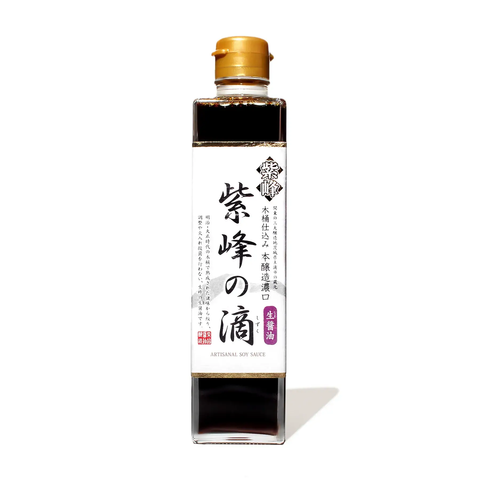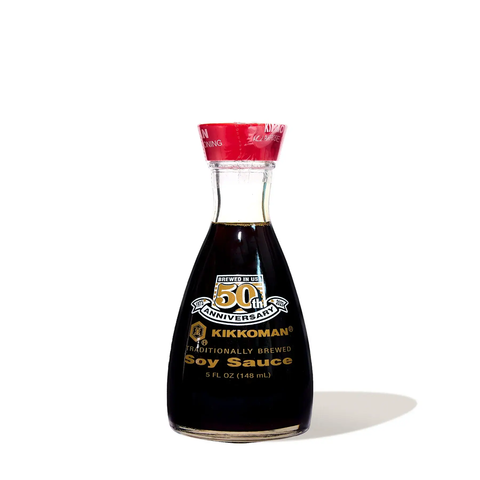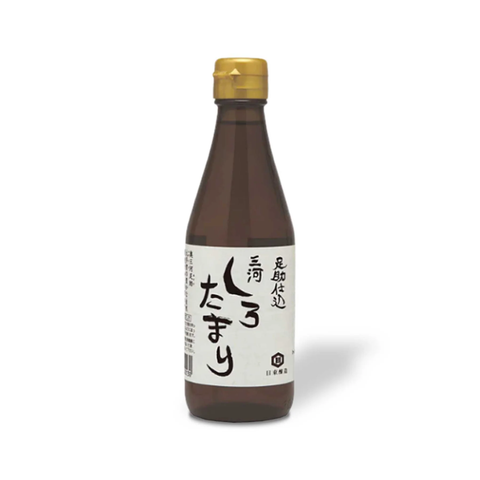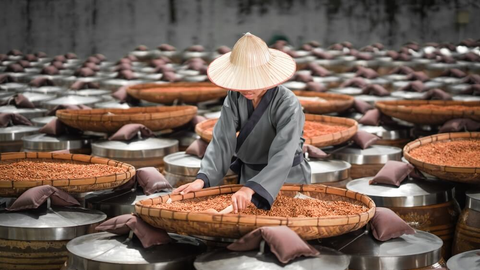4 Best Soy Sauces for 2024: Navigating the Soy Sauce Aisle

Living in New York, I find a lot of things overwhelming, but nothing leaves me dazed like the soy sauce aisle of an Asian grocery store. I would find fifty different soy sauce brands, all with various prices and ingredients. With so many options, you can understand why making a choice can be a nightmare. Recently, it occurred to me that I may not have been alone in my dilemma. People all around the world must face the same problem.
So, with the help of my colleagues at Bokksu Market, I decided to make my own curation of soy sauces and pick the best 4. Together, we sampled 26 different soy sauce brands and carefully took down notes. Our mission? To bring to Bokksu Market not just a soy sauce but a legacy of flavor and a narrative of the East’s culinary artistry.
Our process was extensive, and I’ll reveal more details of that latter in this post. For now, let’s dive in!
Our Soy Sauce Quest
Right from the start, we knew we had a lot of work to do. But with our goal in mind, we rolled our sleeves, and our journey through the intricate world of soy sauces unfolded. Every brand and every bottle was a chapter - a story of ancient Asian recipes and secrets passed down through generations. Together, we tasted dozens of soy sauce products, and after careful observation and sorting, we found the very best. Below are our results. Enjoy!
Shibanuma Artisanal Soy Sauce - The Exquisite One

What we loved: Finely made with moderate saltiness and umami. Subtle woody flavor.
Great for: Making dipping sauce and condiments. Adding to noodles, marinades, and stew.
Under the watchful eyes of my pairs, I discovered the Shibanuma Artisanal Soy Sauce. It wasn’t just a bottle, but a vessel carrying within it the soul of Japanese culinary artistry. Upon my first taste, I remember thinking, “This tastes like it would be perfect for dipping, but also great for noodle dishes.” Such was the exquisite nature of the sauce. According to the manufacturer, the soybeans were matured in 100-year-old wooden tubs. We’ve seen soy sauce brands make similar fermentation claims, but a lot of the time, the taste doesn’t match those claims. This situation was unique because I could taste a faint hint of the aged, ripe flavor that old wooden barrels produce.
Pearl River Bridge Superior Dark Soy Sauce - The Elevated One

What we loved: Darkens and enriches dishes while adding salty umami flavor.
Great for: Flavoring noodles, soups, and rice.
The only way we can describe this sauce is as a rich tapestry of flavors. The Pearl River Bridge Superior Dark Soy Sauce stands as a testament to time-honored Chinese traditions, offering a depth and complexity that elevates every dish it graces. Because I prefer light soy sauces, I haven’t tried too many dark variants. One of our team members is a big fan of dark Chinese soy sauce, and when he described it as, and I quote, “the best one I’ve ever tasted,” I knew I could take his word for it. The Superior lao chou, as it’s called, is a thicker and darker soy sauce than most of the others we tried. It has a deep mahogany color and a velvety texture. There was something naturally nutritious about the taste that I enjoyed. We tried drizzling it over a stir-fry and using it as a marinade. It worked a treat both times!
Kikkoman Soy Sauce with Dispenser Bottle - The One for Every Day

What we loved: Tastes good on both Asian and American dishes. Perfect as a tabletop condiment.
Great for: Stir-frying. Making dipping sauce for sushi.
If you’re familiar with soy sauce, you’d know that there’s a big chance the Kikoman brand would make our list. The Kikkoman Soy Sauce with Dispenser Bottle is popular around the world. Even our tasting team admitted that it was an all-purpose soy sauce, if there ever was one. The glass dispenser bottle is designed to give you better flow control when pouring the sauce. That means it’s easier to add just the right amount for whatever use. Plus, I have to admit that it doesn’t look out of place on my table. The sauce wasn’t too salty. I loved it as part of my grilled chicken marinade and as a flavoring for my tofu. The rest of the team tried it in different ways, and the general consensus was that it tasted good with American and Asian cuisines. It was an everyday sauce with flavors that turned every meal into a celebration.
Mikawa Shiro Shoyu White Soy Sauce - The Unexpected One

What we loved: Complements both taste and color of dishes.
Great for: Making clear soup and rice dishes. Mixing with dashi.
White soy sauce, also called Shiro Shoyu, is less common than dark and light variants. So, forgive me if I wasn’t expecting one of them to make it onto our list of the best soy sauces. I received a few snide remarks when I first mentioned it to the team as one of the sauces to taste. There are a lot of people in the Asian community who don’t consider Shiro Shoyu to be a soy sauce. You can’t blame them, as some manufacturers market products that don’t contain soybeans as soy sauce. However, the Mikawa Shiro Shoyu White Soy Sauce deserves its place on the table.
It's brewed with a higher percentage of wheat, resulting in a delicate, slightly sweet flavor that complements the natural tastes of the ingredients. But it contains soybeans, which means it definitely qualifies as authentic soy sauce. It’s a dance of flavors, where the mild yet complex taste profile enhances dishes without overpowering them, making it a favorite among lovers of moderate umami. It’s a great soup soy sauce if you want to maintain color. Even though I already liked it, I was reassured of my decision to rank it among the best when I noticed how it won over the doubters in the group after a single try.
Our Research
Navigating the intricate world of soy sauces requires more than a palate. You’ll need a deep understanding, a methodical approach, and the humility to acknowledge when a product doesn't meet the mark. At Bokksu, our research is rooted in a combination of our rich history with Japanese flavors and a rigorous process of selection. From our extensive qualifications that make us Asian culinary specialists to our meticulous process of sourcing and testing, we leave no stone unturned. And while our journey has led us to discover some of the finest soy sauces, it has also brought us face-to-face with products that didn't resonate with our standards. Dive in as we unravel our qualifications, our tried-and-true process, and the few that left us wanting more.
Our Qualifications
At Bokksu, our journey with Asian flavors, particularly Japanese, began with a profound love and appreciation for authentic local snacks. Our founder, Danny Taing, after living in Japan, was so enamored by the unique and rich flavors he encountered that he returned to the US with a suitcase brimming with these delightful treats. Recognizing the gap in the market for such authentic flavors, especially those created by local artisans and family businesses in Japan, Bokksu was born. Since its inception in 2016, Bokksu has evolved from a monthly subscription box service to a comprehensive platform offering a curated selection of snacks, lifestyle items, and essential Asian grocery items through Bokksu Market.
Our commitment to sourcing genuine and high-quality products supports our expertise, in addition to our deep understanding and appreciation of Japanese flavors. With the same enthusiasm, commitment, and knowledge that have made Bokksu a reputable name in the world of Japanese culinary delights, we entered the soy sauce market as specialists in Asian grocery items.
Our Process
Finding the best soy sauce was a lengthy process that took us days to complete. There are dozens on the market and we tested 26 of them. We tried different Chinese soy sauces, Japanese soy sauces, and even Korean sauces. Nevertheless, the desire to give our customers at Boksu Market the best was what motivated us. All products are accessible in dozens of countries around the world, so you don’t have to worry about not finding these recommendations in your local store.
The team of panelists I enlisted consisted of Bokksu Market writers, editors, content creators, and QA experts. These are people who have dedicated their careers to researching and understanding the tastes and flavors you (the audience) love. It is safe to say that the quest was in good hands. Every member tested each product in two rounds: first, directly out of the bottle, and second, as a dip or condiment with random dishes. Below are the factors each of us considered in our evaluation:
-
Saltiness
-
Sweetness
-
Texture
-
Color
-
Flavor
-
Food taste improvement
-
Handy packaging
Every member was asked to leave comments and observations based on those factors. At the end, I ranked the products based on the feedback and general opinion of the panelists. While there were some fantastic sauces, we could only pick four. It was difficult, but I’m confident we made the right choices.
Our Disappointments
In our quest to curate the finest soy sauces, we embarked on a tasting journey, sampling dozens of varieties from various brands. While many were commendable, there were a few that, although popular, didn't quite meet our expectations for the discerning palates of our customers. A notable example is the Kikkoman Soy Sauce From Japan. While it's undeniably a classic, boasting a full-bodied, authentic, and aromatic flavor, we found it to be a tad too basic for our clientele. It's a staple in many households and has its merits, but for those seeking a more nuanced and layered taste experience, it might come off as a bit elementary. This revelation was a reminder that not all that glitters is gold, and even renowned brands can sometimes offer products that might not resonate with the refined tastes of our community.
Why Soy Sauce
Soy Sauce Spectrum: Light, Regular, and Dark
Navigating the world of soy sauce unveils a spectrum of flavors, each variant offering a unique sensory experience. Light soy sauce is known for its thinner consistency and lighter hue, offering a more pronounced salty flavor. It’s a favorite for seasoning and enhancing the natural flavors of dishes. Regular soy sauce, the common choice in many households, strikes a balance between its light and dark counterparts. It offers a harmonious blend of saltiness and sweetness, ideal for a variety of culinary applications. Dark soy sauce, on the other hand, is aged longer and often contains added molasses or caramel, giving it a darker color, thicker consistency, and a touch of sweetness. It’s a favorite for cooking, where its rich color and complex flavor profile can transform dishes, adding depth, aroma, and a gourmet touch.
Understanding the nuances of light, regular, and dark soy sauce can elevate your culinary skills. You’ll develop the precision needed to create dishes that are as flavorful as they are visually appealing. But there are so many different kinds: low-sodium soy sauces, tamari shoyu, sweet soy sauce, Korean soy sauce, gluten-free soy sauces, etc.
Soy Sauce Substitutes
For those with soy allergies, dietary restrictions, or simply seeking to explore new flavors, soy sauce substitutes offer a viable alternative. There’s the Tamari soy sauce substitute, which is often gluten-free, provides a similar umami richness with less wheat content. Coconut aminos, derived from coconut sap, offer a sweeter, milder flavor, making it a popular soy-free alternative. Liquid aminos, made from non-GMO soybeans and purified water, are also a gluten-free option that mimics the same savory flavor richness of traditional soy sauce.
Each substitute offers a unique flavor profile, ensuring that the rich, savory experience of soy sauce is accessible to all, regardless of dietary preferences or restrictions.
Soy Sauce Uses

The art of pairing the best soy sauce with foods is akin to a symphony, where each note and flavor harmonize to create a masterpiece. If you know what to do, you can transform ordinary meals into gourmet delights using some of our above recommendations.
With Foods
Soy sauce, a cornerstone of Asian cuisine, has the transformative power to elevate even the simplest of dishes. Within the starters collection at Bokksu Market, this liquid gold enhances flavors and adds depth. Take, for instance, the Shirakiku Shrimp Fried Rice. A splash of soy sauce melds with the chewy shrimp, intensifying the umami and creating a symphony of flavors.
For those who enjoy a touch of spice, the Maesri Thai Green Curry Paste paired with soy sauce offers a harmonious balance between the fiery Thai spices and the savory depth of the soy. And for a classic Japanese experience, the Kikkoman Karaage Japanese-Style Fried Chicken Mix becomes even more delectable when marinated with soy sauce, ensuring each bite is juicy and flavorful. These are just glimpses into the culinary adventures awaiting you when soy sauce meets our curated starters. Dive in and let your taste buds revel in the magic!
With Fish
The ocean's bounty, when paired with the right condiments, can transport you to culinary paradise. Soy sauce, with its deep umami essence, is a match made in heaven for seafood. Dive into the flavors of the sea with Bokksu Market's curated collection of frozen seafood. For instance, the Unagi Kabayaki Grilled Eel is elevated to gourmet status when drizzled with a touch of soy sauce, enhancing the smoky notes of the grilled eel. The Kibun Oden Assorted Fish Cakes (Party Size) become a delightful treat when dipped in a soy sauce mixture, adding depth to the delicate flavors of the fish cakes. And for sushi enthusiasts, the Sashimi-Grade Uogashi Yellowtail Hamachi Buri Loin can be paired with a light soy sauce dip, complementing the freshness of the sashimi.
Whether you're preparing a lavish seafood feast or a simple snack, the addition of soy sauce promises to elevate the experience, marrying the flavors of the sea with the earthy richness of fermented soy beans.
With Heat & Eat
Soy sauce is a versatile condiment that can improve the taste of various dishes, especially when it comes to heat & eat products. At Bokksu Market, our curated collection of microwave-ready meals offers a delightful range of options that pair beautifully with the depth of soy sauce. A perfect example is the Shirakiku Pork & Vegetable Buns. You can enhance it with a light drizzle of soy sauce, adding a savory touch to the already flavorful buns.
Similarly, if you love a hearty bowl, the Yoshinoya Gyudon Cooked Beef with Onion can be taken to new heights with a splash of soy sauce, enhancing the beef's richness. These are just a few examples, but the possibilities are endless. With the right soy sauce, every heat & eat product can be transformed into an exquisite experience.
The Culmination of the Journey
My journey through the world of soy sauces was both thrilling and challenging. Was it worth it? Yes, it was! Discovering Shibanuma, Kikkoman, Pearl River, and Mikawa sauces wasn’t like finding bottles on a shelf; it was finding new life-time companions. I now have a diverse selection of soy sauce options for my meals.
Will we do it again? Also yes! We plan to make this a regular procedure for bringing the best Asian food products to you, including soy sauce. New manufacturers pop up every year, while others make changes to their products. You can trust us to keep you up-to-date with our frequent tests.
I extend an invitation to you. Join me, not just to taste but to experience, to embark on a journey where every drop of Bokksu Market’s curated soy sauces is a step into a mythical world where flavors are narratives.
This article is the first in a series focusing on the personal exploration and meticulous selection of Asian grocery products, with each piece a narrative of discovery, quality, and unmatched flavor.
Author Bio









